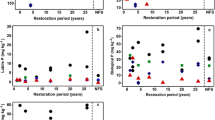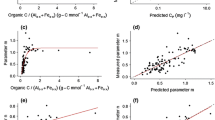Abstract
Forest ecologists and biogeochemists have used a variety of extraction techniques to assess labile vs. non-labile soil P pools in chronosequences, the balance between biological vs. geochemical control of P transformations across a wide range of soil orders, the role of plants with either N-fixing or mycorrhizal symbionts in controlling soil P fractions, and to make inferences about plant-available P. Currently, variants of the sequential extraction procedure developed by M. J. Hedley and co-workers afford the greatest discrimination among labile and non-labile organic and inorganic P pools. Results of recent studies that used this technique to evaluate P fractions in forest soils indicate the following: (1) in intact, highly weathered forest soils of the humid tropics, Hedley-labile P values are several times larger than extractable P values resulting from mildly acidic extracting solutions which were commonly used in the past 2 decades; (2) pools of Hedley-labile P are several times larger than the annual forest P requirement and P required from the soil annually in both temperate and tropical forests; (3) long-term trends in non-labile P pools during pedogenesis are adequately represented by the Walker and Syers' model of changes in P fractionation during soil development. However, to better represent trends in pools that can supply plant-available P across forest soils of different age and weathering status, the paradigm should be modified; and (4) across a wide range of tropical and temperate forest soils, organic matter content is an important determinant of Hedley-labile P.






Similar content being viewed by others
References
Adepetu JA, Corey RB (1976) Organic phosphorus as a predictor of plant-available phosphorus in soils of southern Nigeria. Soil Sci 122:159–164
Aerts R (1996) Nutrient resorption from senescing leaves of perennials: are there general patterns? Ecology 845:597–608
Ahrens LH (1965) Distribution of the elements in our planet. McGraw Hill, New York
Andersen SB (1988) Long-term changes (1930–32 to 1984) in the acid-base status of forest soils in the Adirondacks of New York. PhD thesis. University of Pennsylvania, Philadelphia, Pa.
Berger T, Hager H (2000) Physical top soil properties in pure stands of Norway spruce (Picea abies) and mixed species stands in Austria. For Ecol Manage 136:159–172
Bowman RA, Cole CV (1978) Transformations of organic phosphorus substrates in soils as evaluated by NaHCO3 extractions. Soil Sci 125:49–54
Bray RH (1937) New concepts in the chemistry of soil fertility. Soil Sci Soc Am Proc 2:175–179
Brouwer LC (1996) Nutreint cycling in pristine and logged tropical rain forest: a study in Guyana. PhD thesis. Universiteit Utrecht, Utrecht, The Netherlands
Burghouts T (1993) Spatial heterogeneity of nutrient cycling in Bornean rain forest. PhD thesis, Vrije Universiteit te Amsterdam, Amsterdam, The Netherlands
Campo J, Maass M, Jaramillo VJ, Martínez-Yrízar A, Sarukhán J (2001) Phosphorus cycling in a Mexican tropical dry forest ecosystem. Biogeochemistry 53:161–179.
Chadwick OA, Derry LA, Vitousek PM, Huebert BJ, Hedin LO (1999) Changing sources of nutrients during four million years of ecosystem development. Nature 397:491–497
Chauhan BS, Stewart JWB, Paul E (1981) Effect of labile inorganic phosphate status and organic carbon additions on the microbial uptake of phosphorus in soils. Can J Soil Sci 61:373–385.
Cole DW, Rapp M (1981) Elemental cycling in forest ecosystems. In: Reichle DE (ed). Dynamic properties of forest ecosystems. Cambridge University Press, New York, pp 341–409
Crews TE, Kitayama K, Fownes JH, Riley RH, Herbert DA, Mueller-Dombois D, Vitousek PM (1995) Changes in soil phosphorus fractions and ecosystem dynamics across a long chronosequence in Hawaii. Ecology 76:1407–1424
Cross AF, Schlesinger WH (1995) A literature review and evaluation of the Hedley fractionation: applications to the biogeochemical cycle of soil phosphorus in natural ecosystems. Geoderma 64:197–214
Daubeny G (1845) Memoir on the rotation of crops and the quantity of inorganic matter abstracted from soil by various plants under different circumstances. R Soc (Lond) Phil Trans 179–252
Frizano J (1999) Nature, distribution and significance of phosphorus in forest soils from Puerto Rico, Chile and Brazil. PhD dissertation. University of Pennsylvania, Philadelphia, Pa.
Frizano J, Vieira ICG, Vann DR, Johnson AH, Johnson CM, Zarin DJ (in press) Labile phosphorus in soils of forest fallows and primary forest in the Bragantina region, Brazil. Biotropica
Garcia-Monteil DC, Neill C, Melillo J, Thomas S, Steudler PA, Cerri CC (2001) Soil phosphorus transformations following forest clearing for pasture in the Brazilian Amazon. Soil Sci Soc Am J 64:1792–1804
Giardina CP, Sanford, Jr RL, Døckersmith IC (2000) Changes in soil phosphorus and nitrogen during slash-and-burn clearing of a dry tropical forest. Soil Sci Soc Am J 64:399–405
Hafkenscheid R (2000) Hydrology and biogeochemistry of tropical montane rain forests of contrasting stature in the Blue Mountains, Jamaica. PhD thesis. Vrije Universiteit te Amsterdam, Amsterdam, The Netherlands
Hedley MJ, Stewart JWB, Chauhan BS (1982a) Changes in inorganic and organic phosphorus fractions induced by cultivation practices and by laboratory incubation. Soil Sci Soc Am J 46:970–976
Hedley MJ, White RE, Nye PH (1982b) Plant-induced changes in the rhizosphere of rape (Brassica napus var. Emerald) seedlings. III. Changes in L value, soil phosphate fractions and phosphatase activity. New Phytol 91:45–56
Herbert DA, Fownes JH (1995) Phosphorus limitation of leaf area and net primary production on a highly weathered soil. Biogeochemistry 29:223–235
Jenny H, Arkley RJ, Schultz AM (1969) The pygmy podzol ecosystem and its dune association of the Mendocino coast. Madrono 20:60–74
Johnson CE (1989) The chemical and physical properties of a northern hardwood forest soil: harvesting effects, soil tree relations and sample size determination. PhD thesis. University of Pennsylvania, Philadelphia, Pa.
Johnson CM, Vieira ICG, Zarin DJ, Frizano J, Johnson AH (2001) Carbon storage in primary and secondary forests in eastern Amazonia. For Ecol Manage 147:245–252
Johnson DW, Lindberg SE (1992) Atmospheric deposition and forest nutrient cycling. Springer, New York
Kitayama K, Majalap-Lee N, Aiba S-I (2000) Soil phosphorus fractionation and phosphorus-use efficiencies of tropical rainforests along altitudinal gradients of Mt. Kinabalu, Borneo. Oecologia 123:342–349
Lawrence D, Schlesinger WH (2001) Changes in soil phosphorus during 200 years of shifting cultivation in Indonesia. Ecology 82:2769–2780
Lugo AE, Murphy PG (1986) Nutrient dynamics of a Puerto Rican subtropical dry forest. J Trop Ecol 2:55–72
Lugo AE, Scatena FN (1995) Ecosystem-level properties of the Luquillo Experimental Forest with emphasis on the tabonuco forest. In: Lugo AE, Lowe C (eds) Tropical forests: management and ecology. Springer, New York, pp 59–108
Mattingly GEG (1975) Labile phosphate in soils. Soil Sci. 39:369–375
McGroddy, M, Silver W (2000) Variations in belowground carbon storage and soil CO2 flux rates along a wet tropical climate gradient. Biotropica 32:614–624
Medina E, Cuevas E (1989) Patterns of nutrient accumulation and release in Amazonian forests of the upper Rio Negro basin. In: Proctor J (ed) Mineral nutrients in tropical forest and savannah ecosystems. Blackwell, Oxford, pp 217–240
Morel C, Tiessen H, Moir JO, Stewart JWB (1994) Phosphorus transformations and availability under cropping and fertilization assessed by isotopic exchange. Soil Sci Soc Am J 58:1439–1445
Nelson WL, Mehlich A, Winters E (1953) The development, evaluation and use of soil tests for phosphorus availability. Agronomy 4:153–188
Newberry, DMcC, Alexander JJ, Rother JA (1997) Phosphorus dynamics in a lowland African rain forest: the influence of ectomycorrhizal trees. Ecol Monogr 67: 367–409
Ostertag R, Scatena FN, Silver W (in press) Forest floor decomposition following hurricane litter inputs in several Puerto Rican forests. Oecologia
Post BW, Curtis RO (1970) Estimation of northern hardwood forest site index from soils and topography in the Green Mountains of Vermont. Vt Agric Exp Stn Bull 664:1–17
Scott DA, Proctor J, Thompson J (1992) Ecological studies on a lowland evergreen rain forest on Maracá Island, Roraima, Brazil. II. Litter and nutrient cycling. J Ecol 80:705–717
Sharpley AN, Jones CJ, Gray C, Cole CV, Tiessen H, Holzhey CS (1985) A detailed phosphorus characterization of seventy-eight soils. USDA Agricultural Research Services, technical bulletin aRS-31. U.S. Government Printing Office, Washington, D.C.
Sharpley AN, Tiessen H, Cole CV (1987) Soil phosphorus forms extracted by soil tests as a function of pedogenesis. Soil Sci Soc Am J 51:362–365
Silver WL (1994) Is nutrient availability related to plant nutrient use in humid tropical forests? Oecologia 98:336–343
Silver W, Neff J, McGroddy M, Veldkamp E, Keller M, Cosme R (2000) Effects of soil texture on belowground carbon and nutrient storage in a lowland Amazonian forest ecosystem. Ecosystems 3:193–209
Smethurst PJ (2000) Soil solution and other soil analyses as indicators of nutrient supply: a review. For Ecol Manage 138:397–411
Solomon D, Lehmann J, Mamo T, Fritzsche F, Zech W (2002) Phosphorus forms and dynamics as influenced by land use changes in the sub-humid Ethiopian highlands. Geoderma 105:21–48
Sollins P (1998) Factors influencing species composition in tropical lowland rain forest: does soil matter? Ecology 79:23–30
Sparling GP, Whale KN, Ramsay AJ (1985) Quantifying the contribution from the soil microbial biomass to the extractable phosphorus levels of fresh and air-dried soils. Aust J Soil Res 23:613–621
Stewart JWB, Tiessen H (1987) Dynamics of soil organic phosphorus. Biogeochemistry 4:41–60
Syers JK, Smillie GW, Williams JDH (1972) Calcium fluoride formation during extraction of calcareous soils with fluoride: implications to inorganic P fractionation schemes. Soil Sci Soc Am Proc 36:20–25
Thomas S (1996) The fractionation of phosphorus: biogeochemical and pedogenic implications in soils of the Cordillera de Piuchué, Chile. MS Thesis, University of Pennsylvania, Philadelphia, PA
Thomas S, Johnson AH, Frizano J, Vann DR, Zarin DJ, Joshi AB (1999) Phosphorus fractions in montane forest soils of the Cordillera de Piuchué, Chile: biogeochemical implications. Plant Soil 211:139–148
Tiessen H, Moir JO (1993) Characterization of available phosphorus by sequential extraction. In: Carter MR (ed) Soil sampling and methods of analysis. Canadian Society of Soil Science, Lewis, Boca Raton, Fla., pp 75–86
Tiessen H, Stewart JWB, Cole CV (1984) Pathways of phosphorus transformations in soils of differing pedogenesis. Soil Sci Soc Am J 48:853–858
Tiessen H, Chacon P, Cuevas E (1994a) Phosphorus and nitrogen status in soils and vegetation along a toposequence of dystrophic rainforests on the upper Rio Negro. Oecologia 99:145–150
Tiessen H, Cuevas E, Chacon P (1994b) The role of soil organic matter in sustaining soil fertility. Nature 371:783–785
Vitousek PM (1984) Litterfall, nutrient cycling and nutrient limitation in tropical forests. Ecology 65:285–298
Vitousek PM, Sanford RL (1986) Nutrient cycling in moist tropical forest. Annu Rev Ecol Syst 17:137–167
Walbridge MR (1991) Phosphorus availability in acid organic soils of the lower North Carolina coastal plain. Ecology 72:2083–2100
Walker TW (1964) The significance of phosphorus in pedogenesis. In: Hallsworth EG, Crawford DV (eds) Experimental pedology. Butterworths, London, pp 295–315
Walker TW, Syers JK (1976) The fate of phosphorus during pedogenesis. Geoderma 15:1–19
Williams JDH, Syers JK, Walker TW (1967) Fractionation of soil inorganic phosphate by a modification of Chang and Jackson's procedure. Soil Sci Soc Am Proc 31:736–739
Wood T, Bormann FH, Voight GK (1984) Phosphorus cycling in a northern hardwood forest: biological and chemical control. Science 223:391–394
Wright TL (1971) Chemistry of Kilauea and Mauna Loa lava in space and time. Geological Survey professional paper 735. U.S. Government Printing Office, Washington, D.C.
Zarin DJ (1993) Nutrient accumulation during succession in subtropical lower montane wet forests, Puerto Rico. PhD dissertation. University of Pennsylvania, Philadelphia, Pa.
Zou, D, Binkley D, Doxtader K (1992) A new method for estimating gross phosphorus mineralization and immobilization rates in soils. Plant Soil 147:243–250
Acknowledgements
We thank Marty Dranoff for his help in the laboratory, Phil Sollins, Fred Scatena and two anonymous reviewers for their helpful comments on early versions of this paper. This work was supported by grants from The Andrew W. Mellon Foundation and the National Science Foundation (DEB 9705814).
Author information
Authors and Affiliations
Corresponding author
Rights and permissions
About this article
Cite this article
Johnson, A.H., Frizano, J. & Vann, D.R. Biogeochemical implications of labile phosphorus in forest soils determined by the Hedley fractionation procedure. Oecologia 135, 487–499 (2003). https://doi.org/10.1007/s00442-002-1164-5
Received:
Accepted:
Published:
Issue Date:
DOI: https://doi.org/10.1007/s00442-002-1164-5




